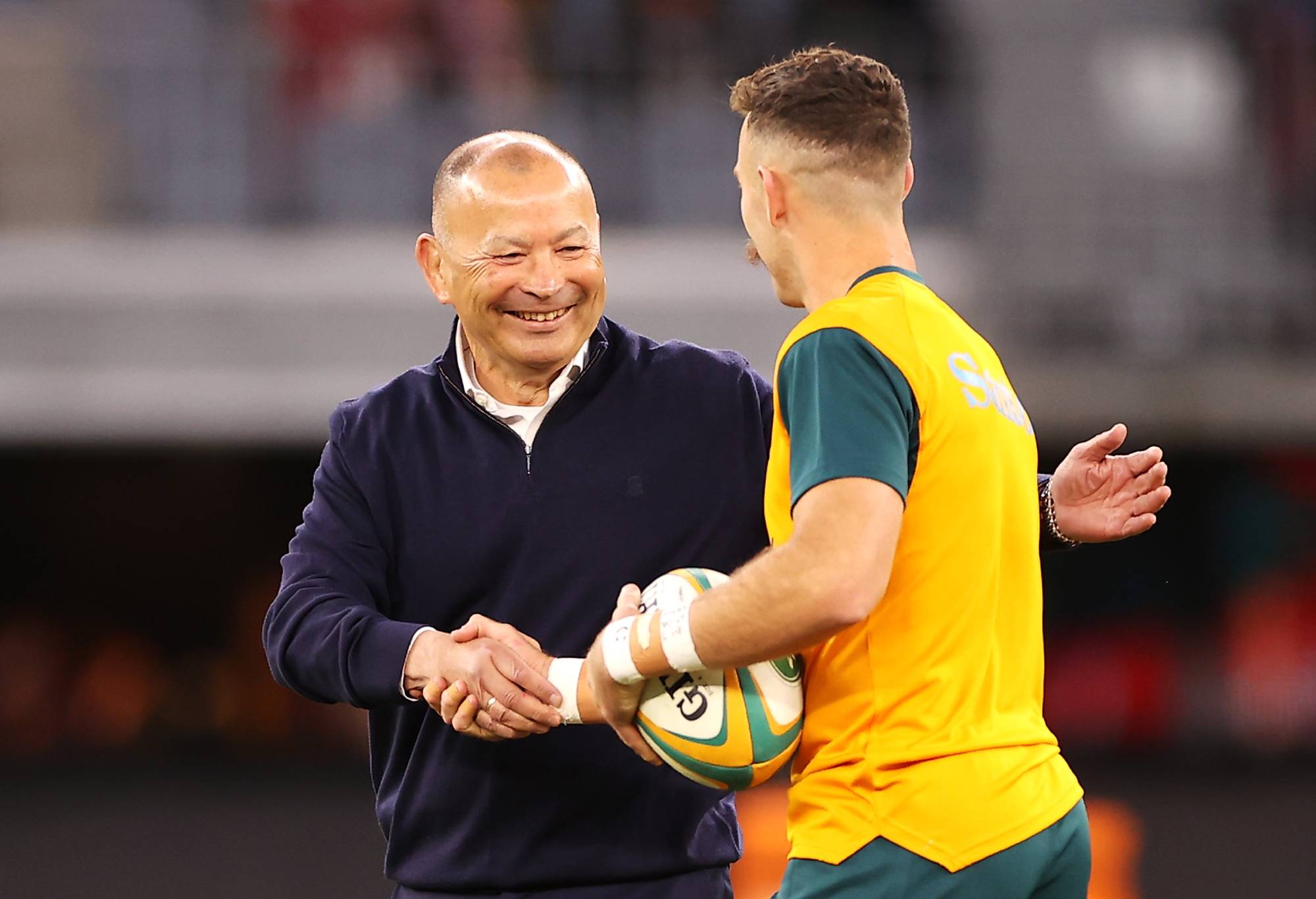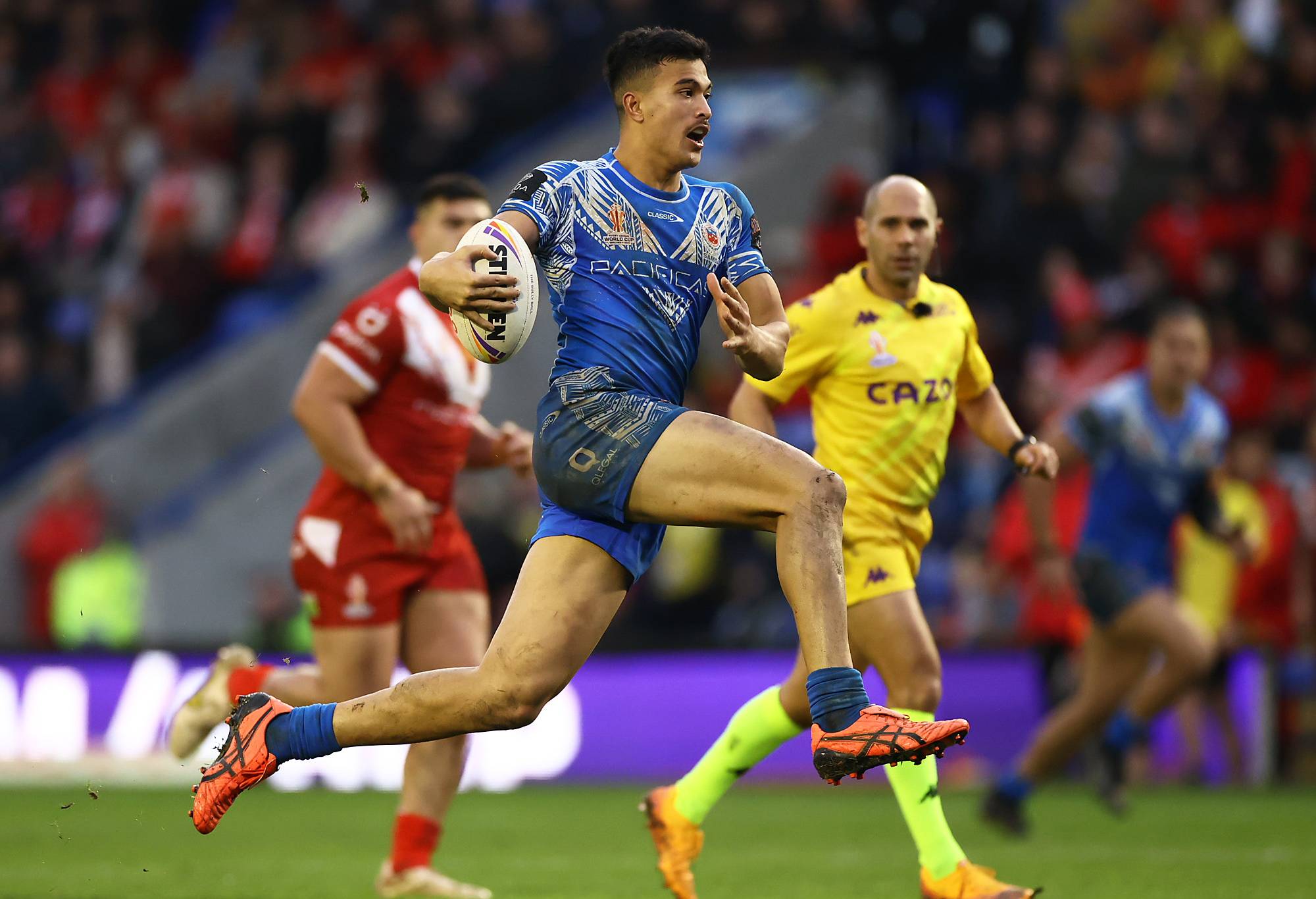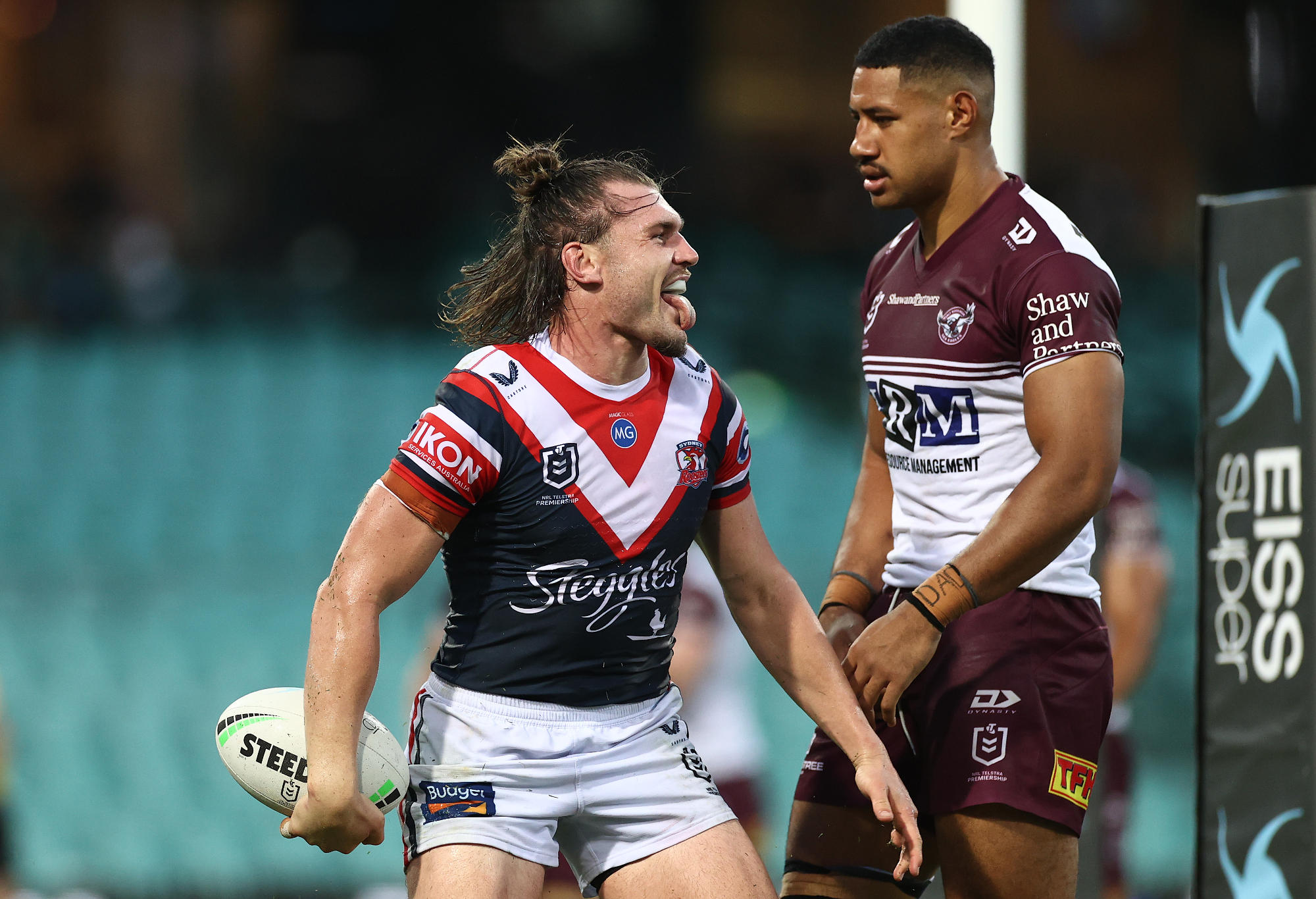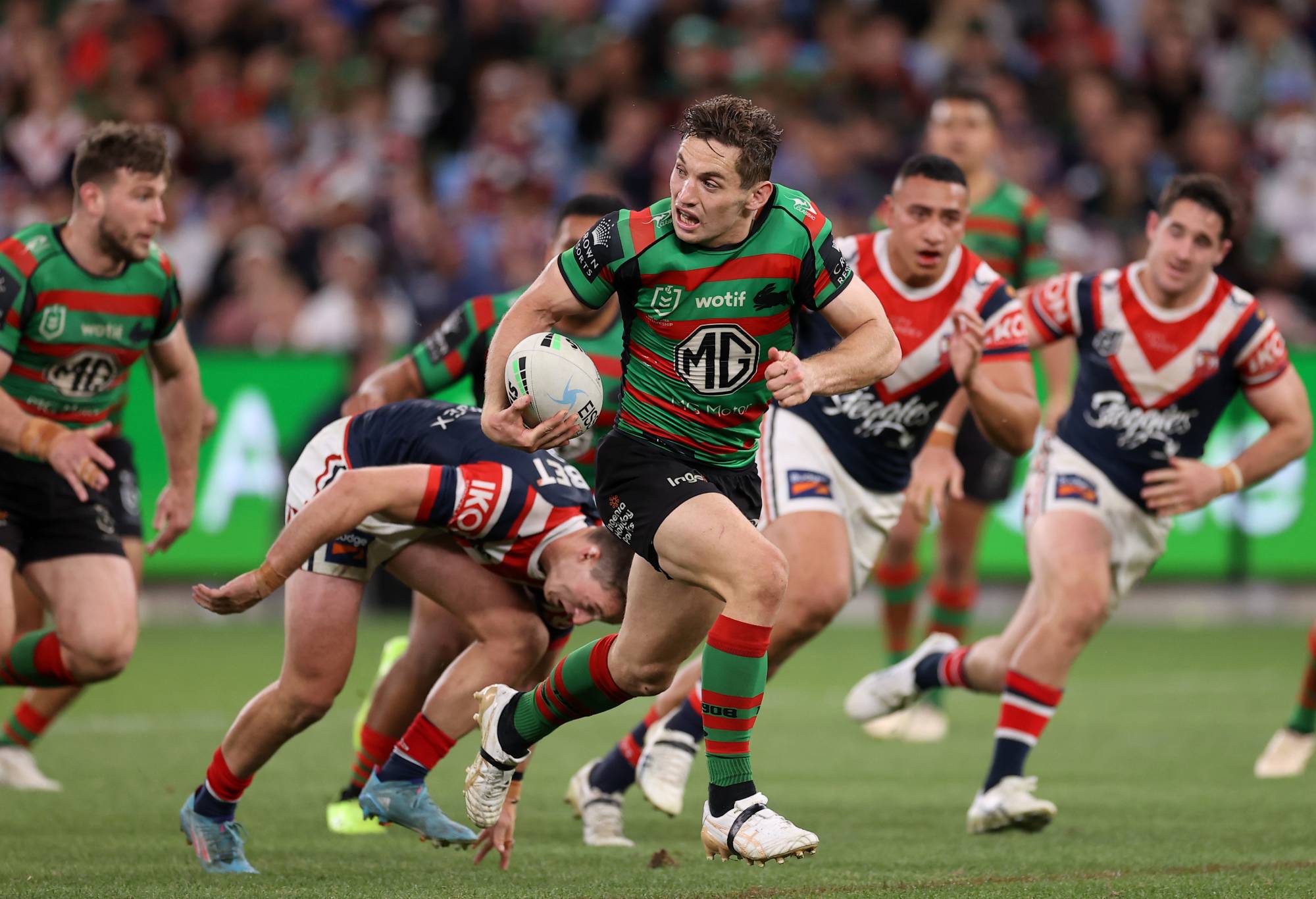Rugby Australia’s decision to bring Eddie Jones back into the fold means the Wallabies will have no more dramas in something that has been a problem area in recent years – attention.
Eddie’s a walking headline and his return as coach will put the Wallabies back in the spotlight, particularly when you compare his profile and propensity for generating publicity to Dave Rennie’s low-key approach.
It’s a crucial time for rugby in Australia with not only a World Cup for the Wallabies in less than nine months on the horizon but a British & Irish Lions tour heading this way in two years before the next World Cup is held Down Under in 2027 and the women’s tournament two years after that.
Rugby Australia is banking on the expected revenue generated by these three showpiece events on home soil to reinvigorate the sport after decreasing interest, TV ratings and crowds over the past decade compared to the golden era around the turn of the century.

Eddie Jones shakes hands with Nic White. (Photo by Mark Kolbe/Getty Images)
And with that financial windfall comes the ability to recruit new talent to the code.
When Australia last hosted the men’s World Cup in 2003 after the first few years of legitimate professionalism and the Super Rugby competition offering full-time contracts for players, rugby’s top brass was able to lure several NRL players to the 15-player code.
Andrew Walker, Mat Rogers and Wendell Sailor were the first three to sign. Walker had played rugby at senior level and Rogers had excelled as a junior while Sailor was a big name project who was converted into a top-level rugby winger at international level despite a few teething problems.
His Broncos teammate Lote Tuqiri followed suit, making his debut midway through 2003 and playing a part alongside Rogers, Walker and Sailor as Jones led the Wallabies to the final before Jonny Wilkinson’s boot eventually sunk them in extra time.
This time around, with Jones ticking off the box marked “generating eyeballs” in Rugby Australia’s master plan for next five years, talent scouts can be more judicious when deciding how to splash the extra cash for talent.

(Photo by Michael Steele/Getty Images)
A marquee name like Sailor is not necessarily needed. RA officials can pinpoint particular players in the NRL based on their skills set or current Wallabies-eligible rugby players who are plying their trade overseas.
Bringing centre Samu Kerevi back from Japan’s Suntory Sungoliath or towering forward Will Skelton from French Top 14 outfit La Rochelle to would take a large chunk out of the available funds but would be worth plenty to boost Super Rugby and reduce complicated Giteau Law permutations for Wallabies selections.
Roosters duo Joseph Suaali’i and Angus Crichton, and Rabbitohs skipper Cameron Murray are the standout candidates for a Wallabies raid among current NRL stars with rugby in their blood.
Suaali’i is still just 19 but already has played 24 games across two seasons in the NRL and represented Samoa at the World Cup. He chose Samoa over Australia because of the chance to play his preferred fullback role.
With captain James Tedesco at the Roosters, he’s not going to get a crack at the back at club level and will be stuck on the wing or in the centres for the foreseeable future.

(Photo by Cameron Spencer/Getty Images)
The Kings School product, who earned Australian Schoolboys rugby selection in 2018, is off contract at the Roosters at the end of this season although he has an option to stick around for 2024.
With his height, speed and unlimited potential, Jones and his new Wallabies brains trust would be mad not to make Suaali’i their prime target. Talk of a $10 million deal over five years surfaced a few months ago – no one from either code will talk ballpark figures on the record but he would certainly be worth that kind of investment for Rugby Australia.
Crichton, 26, was tagged a star of the future as a teenager a decade ago when he was part of The Scots College First XV that won the GPS title before representing NSW and then Australian Schoolboys.
He recently re-signed with the Roosters but the NSW Origin second-rower has only extended his tenure until the end of next year.
Murray, who only turned 25 today, captained Newington College’s first XV to the GPS championship in 2015 before becoming a Rabbitoh, a club where his father Corey played first grade in the 1990s.

(Photo by Mark Kolbe/Getty Images)
“Rugby was always such a fun game to play for me, especially in the centres because you have so much freedom with the ball,” he told the SMH in a 2019 interview when he was breaking into the league representative ranks, adding the ‘23 World Cup would be “too soon” for him to switch back. “I had a serious deal from the Tahs. I was happy at the time because I was wanted and a lot of people saw potential in me from league and union.”
Former rugby sevens star Lachie Miller, who made a promising switch to the NRL last season, is coincidentally set to seal a new deal to play fullback at Newcastle for the next three years. He will be 31 by the time that contract expires so he probably doesn’t fall into the Wallabies’ shortlist of targets even though he has rugby pedigree.
Jones openly admits to watching plenty of the NRL so he will know which players he thinks can make the transition and which positions he sees as needing reinforcement in his prospective Wallabies squad.
With Jones at the helm, you can’t discount anything.
He even floated the idea in recent weeks of trying league himself as a coach.
League chiefs still remember former Wallabies coach Alan Jones’ disastrous attempts to follow in Warren Ryan’s footsteps at Balmain in the early 1990s – just 24 wins from 66 matches at 36% before he was replaced by Wayne Pearce.
It would have been near-on impossible for someone even of his stature to walk into an NRL head coaching gig but you could never totally discount that possibility either.
When he was sacked as Wallabies coach on December 2, 2005, Jones vowed to be back one day.
“There’s no reason why I won’t be coaching the Wallabies again and that’s my intention,” he said a little more than 18 years ago. “I want to become a better coach and coach the Wallabies again. It’s the greatest honour and privilege you can have.”
It was the kind of comment you expect from a coach who has been punted before they think they’re use-by date has expired but you never expect it to happen.
And now it has.
































































































